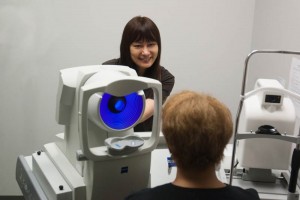Technology and Techniques
Understanding Your Surgical Options for Vision Correction
 When you are considering surgery to improve your vision, you need to know about all your options. First of all, it’s important to understand that there are a variety of procedures available, but they aren’t necessarily interchangeable. Surgical solutions such as LASIK, PRK, cataract surgery, refractive lens exchange, and Phakic lens replacement are designed to treat specific issues. It’s also vital to know which surgeries are available at each clinic you are considering. Some clinics specialize in only one type of operation.
When you are considering surgery to improve your vision, you need to know about all your options. First of all, it’s important to understand that there are a variety of procedures available, but they aren’t necessarily interchangeable. Surgical solutions such as LASIK, PRK, cataract surgery, refractive lens exchange, and Phakic lens replacement are designed to treat specific issues. It’s also vital to know which surgeries are available at each clinic you are considering. Some clinics specialize in only one type of operation.
At Boydvision, we offer five distinct treatments, to meet the broadest array of circumstances. This means we can perform a wider range of vision correction procedures and address the needs of as many prospective patients as possible. We also use advanced technologies for testing and performing these surgeries, to deliver the best possible patient outcomes.
Here’s an overview of three procedures offered by Boydvision and the equipment we use
Cataract Surgery
Cataracts are a relatively common problem for people with aging eyes. As we grow older, the natural lens of the eye can cloud over and diminish vision. Left untreated, it can result in blindness. Thankfully, modern artificial lens can be implanted, restoring vision in a surgical procedure that only takes a few hours from start to finish. At Boydvision we offer two choices for cataract surgery – the basic lens implant, with the cost handled by BC’s government medical coverage and premium lens implants, that aren’t covered by the Medical Services Plan, but do provide additional features and a reduced wait time.
To learn more about Boydvision’s cataract surgery options please visit the cataract surgery page of our website.
Refractive Lens Exchange
Laser vision correction might not be right for you. But if you are over 50 years of age, that doesn’t mean you don’t have options. Refractive Lens Exchange aka IOL (intraocular lens implants) is one way that people need glasses but aren’t suitable for laser eye surgery may be able to improve their vision with a fast and proven surgical procedure. The actual operation takes about ten minutes and involves the removal of the natural lens of the eye with a foldable artificial lens implanted via a tiny incision in the cornea. The micro-incision self-closes and your new artificial lens now offers multi-focal power that can completely eliminate the need for glasses. The complete procedure for both eyes takes less than an hour, including the time for the local anesthetic to take effect.
BoydVision offers four options for IOL implants. The first three are made with concentric focus rings to enable clearer vision both near and far. They are the best choice for people who do a lot of reading, but there is a trade-off of night halos due to the rings, which can be noticeable when driving at night.
Boydvision uses the following multi-focal lens implants.
- TECNIS® Multifocal 1-Piece IOL
- AcrySof® IQ ReSTOR® IOL
- AcrySof® IQ ReSTOR® Multifocal Toric IOL
We also offer another option called the Accommodating Lens Implant
This lens (Crystalens Implant) works much like the natural human lens – bending inside the eye to adjust focus. As opposed to a Multifocal lens implant it has excellent night vision but less effective near vision.
Visit the Refractive Lens Exchange page of the Boydvision website for more info.
Phakic Implant Surgery
For younger patients who aren’t suitable candidates for LASIK or PRK procedures, the Phakic implant can offer a long lasting solution that offers some important benefits. A major advantage of Phakic implants is the fact that they preserve reading vision. It also can address a wider range of nearsightedness. The Phakic artificial lens is implanted behind the iris and in front of the natural lens. Importantly, it can be removed later in life if and when cataract surgery is needed. At Boydvision we use the Visian ICL lens for this procedure.
Boydvision’s Technology
For testing your eyes for all of the above procedures, we use wavefront abberometry and corneal topography mapping. These tests help determine if you are a suitable candidate for a particular procedure and can sometimes also identify various types of corneal pathology. For the actual LASIK operation, an ansatome mechanical microkeratome (a very precise surgical instrument with an oscillating blade) is used to create the corneal flap necessary for the LASIK procedure.
While a newer laser microkeratome has become available on the market, Boydvision continues to use the proven Bausch & Lomb Hansatome microkeratome, widely considered the gold standard in microkeratomes. It delivers essentially the same results as the much-publicized femtosecond laser microkeratome at a lower cost to the patient and also makes it easier to re-lift the flap if retreatment is advised. We continue to monitor the development of laser keratomes and may make the switch when we feel the surgical benefits and/or cost reach a point where patients are better served by this newer technology.
Ready to find out which procedure is most suitable for your vision correction needs. Our free exam and consultation is a fast, no obligation way to help you make this important decision. Please give us a call or book your consultation online to arrange an appointment.
